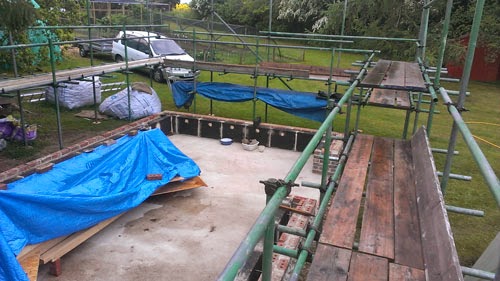POOSHers = 2, Friends = 1. Weather: dry and sunny, rain forecast later (which did not materialise)
And we start week 2 where I left off on Friday - putting hazel stubbies into the base plate and fitting the first course of bales as carefully and as straight as we can. New POOSHers Laura and Jam are here for two weeks, and there are likely to be quite a lot of photos of them.
After completing the first course, the second course is relatively straight-forward bale laying. If I had known my average bale length at the design stage, I would be forging ahead with just the occasional half-bale to make. However, with the slightly shorter-than-expected bales I have bought, a bale needs to be shortened for each of the wall segments, which is five per course (because of the door opening); six on course two (window opening) and seven on courses three and four (two window openings). So most of the day is spent adjusting bale lengths.
Large window box in position sitting on the first course of bales. The box is pinned through the bottom into the bales it is resting on.
Second course nearing completion. We have moved some more bales down from the shelter for tomorrow.
Day 2: Tuesday. Two POOSHers. Weather: warm, cloudy, occasional drizzle
Another day, another course of bales. This is quite a relaxed pace of work for three people. There are bales to dress, careful positioning, bale length adjustments, positioning and pinning of the second window.
We had a "make your own persuader" session first thing, to get ready for bale staking when we reach the fourth course. Logs from the wood store, hazel from the leftover hazel pile.
Small window box, inverted, with its bottom stakes showing. The box is stuffed with sheep fleece insulation.
And this is the end of the day, with the third course completed. Stack of bales in the centre ready for tomorrow, some split bales in the the window box. The wall is getting higher to work on now. We have the scaffold outside, but may not be able to work from it tomorrow because there is rain forecast.
Bale customising with ratchet straps:
I have been experimenting with using a ratchet strap to help compress bales when splitting them. We are putting new bale twine around the bale sections in the conventional manner with a bale needle, but before we tie the strings with a pulley system of hitches, we are using the ratchet strap to compress the bale between two boards.
The string I am holding above is the original bale string which was extremely tight and now has quite a lot of slack in it. Next, you tie up the four new strings (without having to strain to make them as tight as possible), cut the original strings and release the ratchet strap. The straw expands to make a couple of tight bale sections.
We found it was best to have the ratchet on the end of the bale where a board is. If you have it along one side, you get higher tension there than on the other side, and your bale goes all trapezoid.
Day 3 Wednesday. POOSHers = 2, from other networks = 1. Weather: Rain
Rain on and off all day, so inside work under the covers. We have completed the fourth course, "persuaded" the long back wall into the straightest shape we can manage, and staked the first four courses of the back wall will hazel.
We have also stacked sufficient bales to finish the fifth course ready under the building covers. This is a relief, as I had some water leak into the top of my bale stack, and i suspected that it might have penetrated down to the bottom of the stack, but haven't been able to assess the loss until now. I bought around 18 bales more than I needed for contingencies and because of the pack size, and I have water damage to around 14 of them.
 |
| Straightened out with a little persuasion |
 |
| Laura - Straw-lover |
 |
| First stake |
 |
| High stakes |
 |
| More stakes |
Day 4 Friday. POOSHers = 2, Weather warm, dry and sunny.
Thursday was a rest day, so Friday is the fourth and final day of week 2. And it is also the first dry day of the week, so a good opportunity to do some outdoor work. We are going to start making the wall plate, which will sit on top of the final course of bales.
First job: measure the base plate under the bales (again!). The wall plate should be the same size. Then we laid out a rectangle of this size on the grass with fencing pins and bale twine and measured the diagonals to make sure it was a perfect rectangle.
If you read this blog in March, you might have seen that I cut all the OSB for the wall plate in advance. Laid out on the grass today, it was a pretty good fit - it just needed a few millimetres taken of here and there. We laid out, measured and cut 4 x 2 timber on the the OSB for the outer beam.
Cutting noggins with a chop saw. The saw is fixed to the bench, and I have made an end-stop for the timber so we could cut off 350mm lengths without measuring each one
Inner beams cut to length. It is not essential to do overlapping joints, but it's cosmetically very pleasing.
This took the whole day. We'll start next week gluing and screwing the beams to the OSB in six sections, ready for final assembly on top of the straw.































































